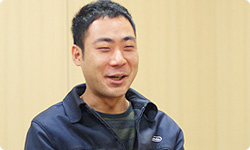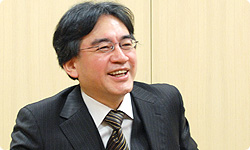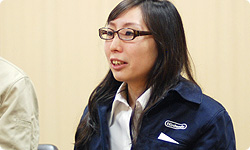3. From Player to Developer
You all grew up with Super Mario Bros. as players but later became video game developers. What brought that about?
When I graduated from university, I only wanted to apply to one company, and that was Nintendo.
Why Nintendo?
When I was in university, I was involved with filming a movie, and once while waiting to film, I was competing with the performers and others on Nintendo 64 games, and it was fun. I was part of the Super Famicom generation, so I had been playing video games forever, but all the Nintendo 64 games were really fun. I thought that, if possible, I wanted to work for Nintendo and develop fun products like that.
What was it like once you came to Nintendo?
I originally wanted to be a designer. Games in 3D were just getting popular, and I had studied 3D along with filming movies. Once I joined Nintendo, I wanted to be a 3D designer, but as soon as I joined the company, (Takashi) Tezuka-san9 said he wanted me to be a planner. 9Takashi Tezuka: General Manager of the Software Development Department of Nintendo's Entertainment and Analysis Division. One of the developers of Super Mario Bros.
As soon as you entered the company?
Maybe it was because my art was no good. (laughs) The first game I worked on was Super Mario Advance 4: Super Mario Bros. 310 for Game Boy Advance. 10Super Mario Advance 4: Super Mario Bros. 3: An action game released for Game Boy Advance in July 2003 as a remake of Super Mario Bros. 3, originally for the Famicom system.

You worked on Super Mario Bros. right from the start.
Yeah. But the game was already almost finished and all that was left was debugging and thinking up new kinds of play for the Card e-Reader Plus .
The e-Reader11 was a peripheral device for Game Boy Advance that read cards with 2D barcodes printed on them. The Card e-Reader Plus was a newer model that could connect with the GameCube and other Game Boy Advance systems. 11Card e-Reader: An accessory for Game Boy Advance released in Japan in December 2001. This device read 2D barcodes printed on e-cards, allowing the player to enjoy minigames and to add new data. The Card e-Reader Plus, which could connect with the Nintendo GameCube and other Game Boy Advance systems, was released in Japan in June 2003.
Yeah. I thought about using it to add levels and show Super Skills movies. So when Super Mario Advance 4: Super Mario Bros. 3 was finished, I focused on making Super Skills movies for Super Mario Advance 4: Super Mario Bros. 3 with the Mario Club.12 12Mario Club Co., Ltd.: Test plays and debugs software being developed by Nintendo.
You made them yourself?
Yeah. I wasn’t really that good at video games, but (Shigeyuki) Asuke-san13, who later directed New Super Mario Bros. Wii, took care of me. However, Asuke-san had extremely high expectations for the quality of the Super Skills movies. He’d be like, “Be sure to go down the very centre of the pipe!” and “Don’t jump any more here than is necessary!” And then, just when I thought I’d done a good job, he’d pan it, saying, “It doesn’t look like a real person played it.” 13Shigeyuki Asuke: He is in the Software Development Department, Entertainment Analysis and Development Division.
It looked so smooth that it didn’t look like you’d actually played it! (laughs) I heard that Asuke-san’s demands were so strict that someone on the staff actually wept.
(straightforwardly) That was me!
(laughs)
Everyone talked about the Hint Movies in New Super Mario Bros. Wii, but it was tough, schedule-wise, and there was talk we should leave them out. Because of my experience seven years earlier, though, I thought they were a great feature, so even if making them would be hard, I thought we should include them.
Your experience crying as you and Asuke-san laboured over them seven years earlier led to the Hint Movies in New Super Mario Bros. Wii.

Yep.
You want to say to everyone, “Don’t forget that!”
Yeah. I’d like to use this occasion to get that point across! (laughs)
Understood. (laughs) Nishimura-san, what got you into becoming a game developer?
I’ve played all the Super Mario Bros. games, but playing Super Mario Bros. 3, in particular, made me think, “What cute graphics!”
You wanted to be a designer at first, so you noticed the art.
Yes. It really grabbed me the way Mario would change into so many different forms. (laughs) I was also really impressed by how his cute appearance and abilities after the transformation could be seen in a single glance.
So you were aware rather early on that you can readily tell function from the way game elements look.
Well, as a child, of course, I was just absorbed in playing the game without noticing anything like that, but as I got a little older, I began to think, “What exactly was so fun about Super Mario Bros. 3?”
About when did you take an interest in working in video games?
After I became a university student. When I was playing video games with my friends, everyone’s faces would light up, which isn’t something you see very often. And that’s not just true for the person playing the game, but every member of the family can enjoy themselves. That made me want to go into a profession that would create such happy faces. I was never that good at video games, but my brother was really good and I grew up watching him play, so I was always interested in what it was that could make someone get so deeply involved in a game.
You came out of the Nintendo Game Seminar14, right? 14Nintendo Game Seminar: A hands-on seminar hosted by Nintendo in Japan. It allows students to experience video game creation.
Yes, that’s right. I really loved the Super Mario Bros. series, so I took the game seminar. I wanted to understand through making a video game what video games are and if I really liked them.
What was it like when you actually made a game? I imagine you thought something quite different than “Video games are fun to play” and “Work that makes people smile is good.”
Yes. I was really struck by how hard it was! (laughs) At the game seminar, we thought up a puzzle game, but everyone really struggled with it.

Even what strikes players as completely natural can’t be achieved unless a number of developers really knock themselves out over it.
Yeah. I learned through hard work, until I was about sick of it, just how difficult developing a game is.
How about since coming to work for Nintendo?
Right now, I’m involved in a slightly special kind of design - visual effects called effect design - so...
Could you tell us a little about what effect design is?
Generally, it’s about making visible what might otherwise not be visible - immediately conveying to players what is going on within the game by, for example, generating a flash of light when they bump into something or creating an environment like rain falling on them.
Like lines for dramatic effect in manga. You try to create visual effects for making it easy to understand what is happening by representing even things that can’t be seen in the real world.
Yeah. That’s exactly right. I’d played the games of the Super Mario Bros. series and had always wondered why it was that while certain things are represented so simply, you instinctively understand them at a glance, so I feel like it is fate that now I can do this kind of work.
Someone who once played the games and sensed how rewarding they can be is now making such games.
Yeah! I once played Super Mario Bros. 2 and Super Mario Bros. 3, and now, as a developer, I have to propose ideas that will convey the same feeling and functions that I once experienced as a player, and that’s very rewarding.
